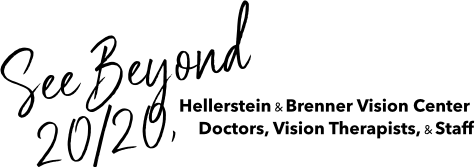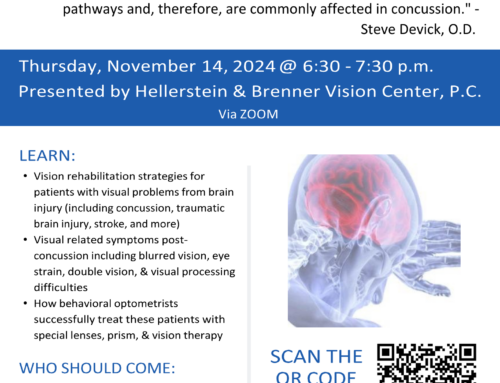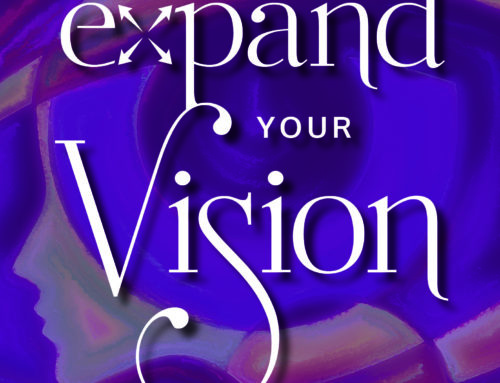WHAT IS BRAIN INJURY
Acquired Brain Injury (ABI) is the summary term for a traumatic event (such as a concussion) or medical condition (such as stroke) resulting in damage to the brain. An ABI often impacts daily function.
What can cause a brain injury?
- Traumatic Brain Injury (or TBI) examples include: concussion from a motor vehicle accident, fall, sports/recreational impact with another play or object
- Neurological disease examples include: multiple sclerosis, cerebral palsy
- Other medical conditions examples include: stroke, tumor, aneurism
CRITICAL CONNECTION BETWEEN BRAIN INJURY AND VISION
Brain injuries often interrupt the communication between the eyes and the brain.
- There are 34 different areas in the brain that are primarily or totally involved with the processing of visual information.
- More areas of the brain are dedicated to the processing of visual information than all other sense modalities
Studies state that at least 50 percent of traumatic brain injuries result in patients suffering from visual dysfunctions. A study even found a 90 percent incidence of post-trauma visual complications.
COMMON VISION PROBLEMS & SYMPTOMS FOLLOWING A BRAIN INJURY
Visual deficits can often be overlooked during initial evaluations, as visual symptoms do not always present immediately after injury and/or the visual symptom is not always presented with the patient’s immediate concerns.
Often following a concussion, patients’ ocular (eye) health and clarity (20/20 vision) is assessed and determined to be healthy and clear, however more extensive visual processing testing should be completed.
Visual processing complications resulting from a traumatic brain injury are known as Post Trauma Vision Syndrome (PTVS). These vision problems affect activities of daily living and when left untreated, can have significant consequences.

*Image courtesy of Neuro-Optometric Rehabilitation Association (NORA) at noravisionrehab.org
Some of the most common symptoms include….
- BLURRED VISION:
- Experiencing blurry vision can present as constant or intermittent, during distance and/or near tasks. Adjusting focus from far to near (accommodation) can be particularly bothersome after a concussion.
- SENSITIVITY TO LIGHT:
- This can include difficulty transfer from darker settings to lighter settings (and vice versa) and inability to tolerate glare and bright lights. Often times this results in the inability to tolerate LCD screens (such as from computers, smartphones, TVs, and tablets)
- REDUCTION OR LOSS OF VISUAL FIELD
- HEADACHES WITH VISUAL TASKS:
- Can present as overall fatigue, visual strain, eye strain/discomfort, eye rubbing, excessive blinking with tasks such as reading, computer work, writing/drawing, etc.
- READING DIFFICULTY:
- Symptoms can present as losing place while reading, skipping words and lines, needing to use a finger to keep place, re-reading often, loss of focus, being easily distracted, and poor comprehension
- DIFFICULTY WITH EYE MOVEMENTS:
- Eye movements are extremely important to complete everyday tasks such as reading and writing. Discomfort (even pain) and inaccuracy of eye movements can be noticed as you change focus and look in different directions
- SENSITIVITY TO MOTION:
- Often times, those who have suffered a concussion struggle filtering movement such as being overwhelmed when scrolling on the computer or phone, as well in grocery stores, crowded restaurants, sporting events, processing moving objects (like a passing car) and other busy environments.
- DIZZINESS AND BALANCE PROBLEMS:
- This can impede mobility and stability of movement including tasks like walking, running, standing, driving, etc.
- BINOCULAR VISION PROBLEMS:
- Convergence insufficiency: The inability to properly attend and point the eyes to near objects, like when looking at a computer screen, while reading. This can result in reading-based difficulties, double vision, headaches, and discomfort.
- Depth perception problems: Difficulty judging where objects or people are in space, difficulty judging timing with movement, difficulty with eye-hand coordination
- Double vision: Can present as ghosting of images, partial multiple images, two complete images. Can present as constant or intermittent, during distance and/or near tasks. Often disorienting resulting in dizziness, discomfort, difficulty balancing, mobility including walking, reading, and driving,
- PERIPHERAL VISION PROBLEMS:
- Difficulty with peripheral vision can present as being easily started, bumping into things frequently, and/or experiencing tunnel vision. Peripheral vision problems are the reduced awareness of objects or people in one’s side (peripheral) vision.
TREATMENT OPTIONS FOR THOSE WHO SUFFERED BRAIN INJURY
Following a traumatic brain injury, a full/comprehensive examination with an optometrist that is trained in the evaluation and management of vision complications post-concussion should be completed. To locate a provider near you, please visit covd.org and noravisionrehab.org.
A comprehensive examination will evaluate the visual processing system beyond clarity and ocular health. Each injury is unique, requiring many areas to be evaluated with some areas having higher priority than others dependent on the injury and the symptoms.
Testing can include (but is not limited to):
- Ocular movements and coordination (such as eye tracking)
- Binocular vision (eye-teaming)
- Visual field testing
- Spatial awareness (such as mid-line testing) and depth perception
- Cognitive processing (visual memory, speed of processing)
- Posture
- Motor output (such as fine motor, gross motor, gait)
- Integration with other sensory symptoms (such as the vestibular system)
A team or multi-disciplinary approach to treating a concussion is most effective and often vital to a patient’s recovery. Limiting care to just one type of rehabilitation often limits the success of treatment and typically falls short of addressing all of the patient’s needs. In addition to the care of a developmental/behavioral optometrist, essential team members can include physical and occupational therapists, cognitive therapists, speech-language pathologists, physical medicine and rehabilitation physicians, neurologists, neuropsychologists, audiologists, ophthalmologists, and many others.
Neuro-optometric vision rehabilitation with a developmental/behavioral optometrist and vision therapist team is a significant part of post-concussion care team.
WHAT IS NEURO-OPTOMETRIC VISION REHABILITATION?
Neuro-optometric vision rehabilitation is an individualized treatment evaluation and (therapy) program for patients suffering from visual disorders related to or as a result of an acquired brain injury (including concussion, traumatic brain injury, stroke, or neurological disease).
Treatment in a neuro-optometric vision rehabilitation program can include:
- Neuro-functional (otherwise known as therapeutic lenses) spectacle correction:
- Refractive lenses
- Prism lenses
- Tinted lenses
- Coated lenses (specific glare-reduction coatings)
- Specialized neuro-functional occlusion (ex: bi-nasal occlusion)
- Often spectacles are prescribed for specific tasks (driving only, reading only, computer only)
- Photo-light therapy (Syntonics)
- Visual perceptual evaluation
- Active in-office Rehabilitative Vision Therapy
RESOURCES CITED:
ADDITIONAL RESOURCES RECOMMENDED:
HELLERSTEIN & BRENNER VISION CENTER LECTURE: Concussion: How Vision is Impacted
Brain Injury Association of America
Brain Injury Alliance of Colorado
Neuro-Optometric Rehabilitation Association (NORA)
ADDITIONAL RESOURCES RECOMMENDED:
Getting Hit, Getting Up, Moving Beyond by Joanne F. Cohen, MA, CBIS
The Ghost in my Brain by Clark Elliott, Ph.D.
See it. Say it. Do it! By Dr. Lynn Hellerstein
Textbook of Traumatic Brain Injury by Jonathan M Silver MD, Thomas W McAllister MD, and Stuart C. Yudofsky MD.





